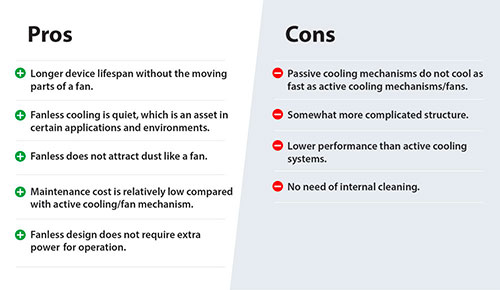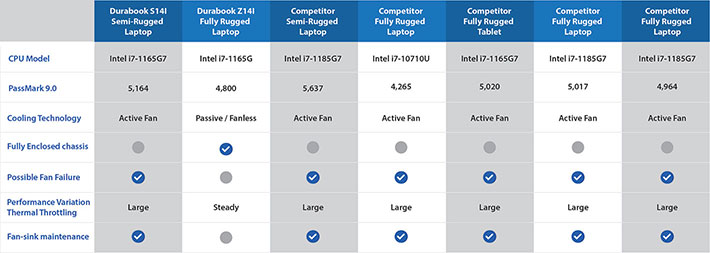|
|
|
|
Cooling Methods of Rugged Mobile Devices -- A Look at the Pros and Cons of Active and Passive Cooling
When the going gets tough enough to require a certifiably rugged mobile tablet or laptop, field workers rely on that device to meet performance and connectivity expectations while keeping cool under the assails of heat, dirt and dust, potentially explosive gasses, and the blazing sun.
(By Sasha Wang, president, Durabook Americas, Inc. Sasha Wang is president of Durabook Americas, the business division that specifically and exclusively serves the commercial sector of North America. She has nearly 20 years' experience in the rugged-computer industry and previously served as Durabook's director of global sales and marketing.)
The purpose of thermal cooling on any computing system is, ultimately, to achieve a stable working system under user desired application scenarios. The cool factor starts with handling the heat that computer electronics themselves generate and releasing it, so components don't melt down. A fan or lack of it isn't the only factor that keeps a rugged mobile device cool or not, the debate over fanless vs. fan / passive vs. active cooling is still a hot issue.
Rugged mobile computing and their cooling solutions continue to evolve. The latest in passive vs. active cooling in mobile devices can help guide users to the tablet or laptop computer most appropriate for the work environment and performance requirements. The pros and cons and best applications of cooling with a fan or without are explored here. Different scenarios call for different levels of system cooling.

The Durabook U11 Rugged Tablet in use in the Saudi Arabian desert. Image Courtesy of Deep Climate for Human Adaptation Institute.
Cooling Method 1 — Active with a Fan
Starting with the design of device cooling with fans, simply put, a fan intakes ambient temperature air, runs it over a form of heat exchanger, and then exhausts the hot air. This is the most common and an effective method of thermal cooling. There are many industries and applications where this form of cooling in a mobile laptop is sufficient.
In fully rugged systems, the fan sits in an encapsulated area sealed away from the inside of the system. Heat generated by the electronics is transferred via copper "heat pipes" from the CPU and memory elements to a finned heat exchanger that's then cooled by the fan. Encapsulation of the fan does not require a large space and it protects the rest of the computer components from exposure to dirt, dust, and particles in the air. Heat removal is quickly and easily accomplished, and the computer may attain high performance.
The fan itself, however, is exposed to contaminants in the air as they pass through the fan/heat exchanger compartment where they can clog the fan, leading to overheating and disruption of operation. More active maintenance to clean the fan and filters can avert overheating but requires repeatedly taking the device offline and out of use.
As a mechanical system, a fan's parts will naturally wear out over time and need to be replaced. Repairs contribute to a higher cost of ownership, along with the cost of computer downtime.
In daily operations, running a fan to cool the computer consumes more of the device's power. And, high RPM fans come with noise, which can be more than annoying in specific environments. There are many industries and applications where this form of cooling in a mobile tablet or laptop is sufficient.
Cooling Method 2 — Passive Heat Dissipation
In passive cooling, distilled to its simplest, heat is distributed to the chassis to be released to the surrounding air. Fanless systems contain no mechanical / moving parts and do not draw contaminants in the air into the device. These factors add to increased reliability and an extended product lifecycle, resulting in lower maintenance costs and thus a lower total cost of ownership (TCO).
 In a fully integrated thermal solution design, a copper heat pipe and magnesium alloy plate/casing are coupled to disperse and dissipate CPU heat, lowering system temperature. In a fully integrated thermal solution design, a copper heat pipe and magnesium alloy plate/casing are coupled to disperse and dissipate CPU heat, lowering system temperature.
Heat spreads evenly throughout the system chassis, except for the battery compartment that is isolated for maximum protection.
By physics, the amount of heat that can be dispersed and dissipated is proportional to the surface area designed for cooling. So, while a tablet or smaller device may feel warm to the touch, any rugged device should comply with the IEC62368-1 Touch Temperature safety standard for human operation.
The configuration of the system should be fine-tuned for performance under various thermal conditions to provide proficient cooling with comparable performance.

Source: PassMark site (https://www.cpubenchmark.net/cpu_list.php)
The fully sealed aspect of a fanless design provides another layer of security by enabling them to operate safely in industries where standard rugged computers cannot. This includes environments with more dust, fine particle contaminants, and potentially explosive gasses, such as oil refineries, gas plants, mills, mines, and manufacturing environments for chemicals and food.
Another benefit is that fanless mobile devices are quiet. There are environments where silence can be lifesaving — law enforcement and public safety applications, and military and defense deployments.

Source: Chart by Durabook Americas
Other Aspects of Cooling
Other ways in which a device keeps its cool is through numerous sensors that continuously check temperature, for example, of the CPU, or Electronic Circuit Board. If things get too hot, the electronics slow themselves down so as not to overheat.
Intel processor specs always include Thermal Design Power (TDP), i.e., the maximum amount of heat the processor generates that the system must be able to get rid of. TDP represents the theoretical heat generation ceiling of a piece of computing equipment. A higher TDP can be seen as representative of more computing power and better processor performance.
According to Intel, "The TDP is the maximum power that one should be designing the system for. Power consumption is less than TDP under lower loads. This ensures operation to published specs under the maximum theoretical workload."
Conclusion
In terms of system cooling effectiveness in the ruggedized PC industry, there is no definite answer as to which - active or passive cooling - is better than the other. Factors about the environments in an industry and application are key determinants of which rugged mobile laptop or tablet is 'right' for any given situation. It comes down to the application environment and levels of reliability and durability desired by the customer.
For example, running office applications, browsing the Internet, watching online videos, accessing data-intensive servers, each of these computing applications require different levels of thermal management to function at their optimum.
Just as there are many levels of device ruggedness, and a variety of ways to measure how rugged a laptop or tablet may be, there are multiple ways to cool a device and to measure the "effectiveness" of a cooling system. Measuring "effectiveness" should go beyond simply how "cool" the system is running, to also evaluate the total cost and value of the system behind it. Comparable performance, presence or lack of noise, impact of active moving components, their maintenance, potential system downtime, and effect on TCO are keys for the measure of the thermal solution of a good, ruggedized product. -- Sasha Wang, September 2023
|
|






